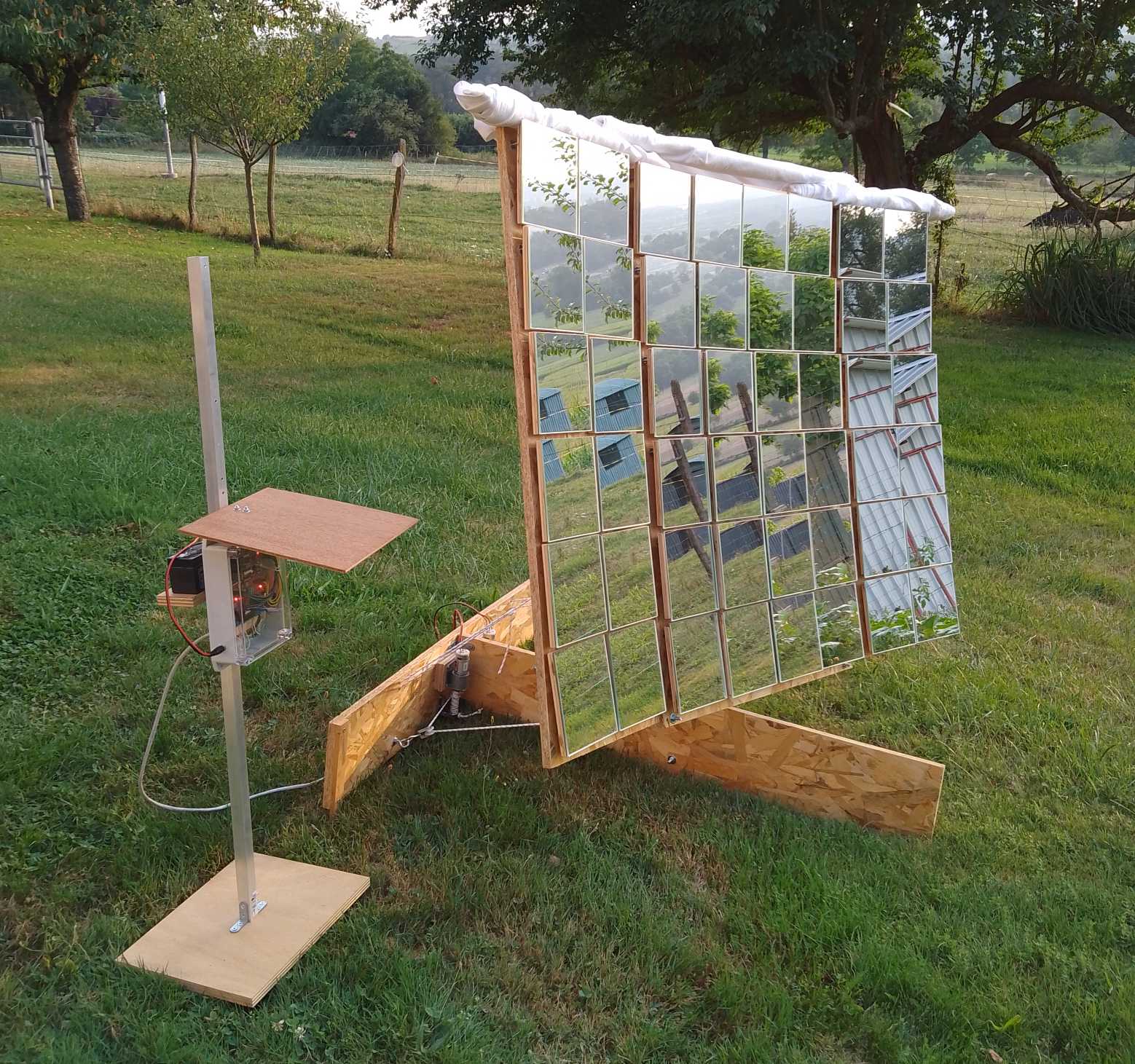This project is a homemade automated solar concentrator 🔧 ☀️ 🔎
It consists of:
- An orientable mirror panel (currently 48 focusing mirrors, totaling 1m²)
- A fixed target (currently a simple concrete oven with a black metal plate and a tempered glass)
- The supervisor: an electronic control device that measures the target, computes and sends commands to the motors
On 26 june 2024, when adding some aluminium foil inside the oven to improve insulation, the oven temperature has risen to 210°C after 30 minutes.
The video below shows the concentrator in action on 8 July 2024:
- First half of the video is the assembly (speed x10)
- Second half is the automatic sun tracking for about 7 hours (speed x600)
solar_concentrator_manip_20240708.mp4
Caution
It can cause permanent blindness, burn skin or ignite objects.
Even when the concentrator is not powered, the sun remains concentrated 48 times in a single small area.
This focal point is constantly moving along a path that is difficult to predict.
In its current state, it must be continuously monitored and the mirrors must be covered quickly in the event of an anomaly.
- Can produce up to about 1000 watts of heat while consuming 3.8 watts of electrical power 💰
- Uses only standard, cheap and available components and materials 🧱 🔩
- Does not require a high precision construction, everything can be built by hand with common tools 📏 🪚
- Easy to assemble and disassemble 🪛
- Easy to understand and modify 🔎
- Open source 🔓
Limitations of this version:
- There is no safety layer implemented (see warning above
⚠️ ) - An initial manual step is required to orient the panel before it can automatically track the sun
- Only one panel can be controlled
- Does not work on cloudy days (it is the user's responsibility to remove the clouds from the sky 😄)
- Power consumption could be significantly reduced through the implementation of various low-power modes
To build this project, some products were happily "hacked" out of their original use:
- The tempered glass used in the oven is from an Ikea shelf
- The mirrors are decorative bathroom mirrors
- The motors are cheap model engines
The project structure reflects the technical breakdown.
Detailed information can be found in the corresponding subfolders:
- Mechanics ⚙️ : 3D models of the parts used in the solar panel
- Electronics 🔌 : schematics and layout of the custom supervisor board
- Software 💾 :
- Simulator : evaluates the theoretical power received by the target for a given hardware configuration
- Supervisor controller : ESP32-CAM firmware based on Espressif ESP32 framework
- Supervisor component defines the supervisor high level logic
- Sun tracker computes motors commands to keep the sun light at the center of the target area
- Target detector detects the target position in image
- Web interface allows the user to interact with the supervisor
- Motors component controls the motors from the ESP32 application
- Image component provides general image processing functions
- Motors controller : Arduino Pro Mini firmware for controlling motors
The next step is to control any number of panels to obtain a power output of several kilowatts.
This would open up the following possibilities:
- Quickly boil a large volume of liquid
- Desalinate or sterilize a large volume of water
- Cook or sterilize a large volume of food
- Melt plastic, metal or glass
- Increase the output of photovoltaic panels with concentrated photovoltaics
Copyright (C) 2024 Rémi Peuchot (https://remipch.github.io/)
- The software is distributed under GNU GPL v3
- Hardware designs (electronics and mechanics) are distributed under CERN Open Hardware Licence v2 Strongly Reciprocal
